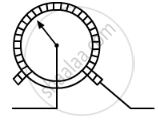Advertisements
Advertisements
प्रश्न
A copper wire has diameter 0.5 mm and resistivity of 1.6 × 10−8Ω m. What will be the length of this wire to make its resistance 10 Ω? How much does the resistance change if the diameter is doubled?
उत्तर
Given diameter of the wire,
D = 0.5 × 10−3 m
resistivity of copper, ρ = 1.6 x 10−8 ohm m required resistance, R = 10 ohm
As R = `(ρl)/A, l = (RA)/ρ = (R((piD^2)/4))/ρ = (πRD^2)/(4ρ)` ...`[∵ A = pir^2 = pi(D/2)^2 = (piD^2)/4]`
∴ `l = (3.14 xx 10 xx (0.5 xx 10^-3)^2)/(4 xx 1.6 xx 10^-8)`
m = 122.7 m
Since `R = (ρl)/((πD^2)/4)`
= `(4ρl)/(πD^2), R∝1/D^2`.
When D is doubled, R becomes `1/4` times.
APPEARS IN
संबंधित प्रश्न
Use the data in the Table given below to answer the following –
Which among iron and mercury is a better conductor?
Table give below Electrical resistivity of some substances at 20°C
| Electrical resistivity of some substances at 20°C | ||
| − | Material | Resistivity (Ω m) |
| Conductors |
Silver | 1.60 × 10−8 |
| Copper | 1.62 × 10−8 | |
| Aluminium | 2.63 × 10−8 | |
| Tungsten | 5.20 × 10−8 | |
| Nickel | 6.84 × 10−8 | |
| Iron | 10.0 × 10−8 | |
| Chromium | 12.9 × 10−8 | |
| Mercury | 94.0 × 10−8 | |
| Manganese | 1.84 × 10−6 | |
| Alloys |
Constantan (alloy of Cu and Ni) |
49 × 10−6 |
| Manganin (alloy of Cu, Mn and Ni) |
44 × 10−6 | |
| Nichrome (alloy of Ni, Cr, Mn and Fe) |
100 × 10−6 | |
| Insulators | Glass | 1010 − 1014 |
| Hard rubber | 1013 − 1016 | |
| Ebonite | 1015 − 1017 | |
| Diamond | 1012 − 1013 | |
| Paper (dry) | 1012 | |
Why are copper and aluminium wires usually employed for electricity transmission?
List the factors on which the resistance of a conductor in the shape of a wire depends.
What is the general name of the substances having infinitely high electrical resistance?
Which has less electrical resistance : a thin wire or a thick wire (of the same length and same material)?
Classify the following into good conductors, resistors and insulators:
Rubber, Mercury, Nichrome, Polythene, Aluminium, Wood, Manganin, Bakelite, Iron, Paper, Thermocol, Metal coin
Which among iron and mercury is a better conductor of electricity?
A wire is 1.0 m long, 0.2 mm in diameter and has a resistance of 10 Ω. Calculate the resistivity of its material?
How does the resistance of a conductor depend on:
length of the conductor?
What would be the effect on the resistance of a metal wire of:
increasing its diameter?
How does the resistance of a wire change when:
its material is changed to one whose resistivity is three times?
The figure blow shows a variable resistor in a dimmer switch.

How would you turn the switch to make the lights: (a) brighter, and (b) dimmer? Explain your answer.
Resistance of a metal wire of length 5 m is 100 Ω . If the area of cross - section of the wire is `3 × 10^-7 "m"^2` , Calculate the resistivity of the metal .
Materials which allow larger currents to flow through them are called:
The element used almost exclusively for filaments of incandescent lamps:
How will the resistance of a wire be affected if its
- length is doubled, and
- radius is also doubled ?
Give justification for your answer.
